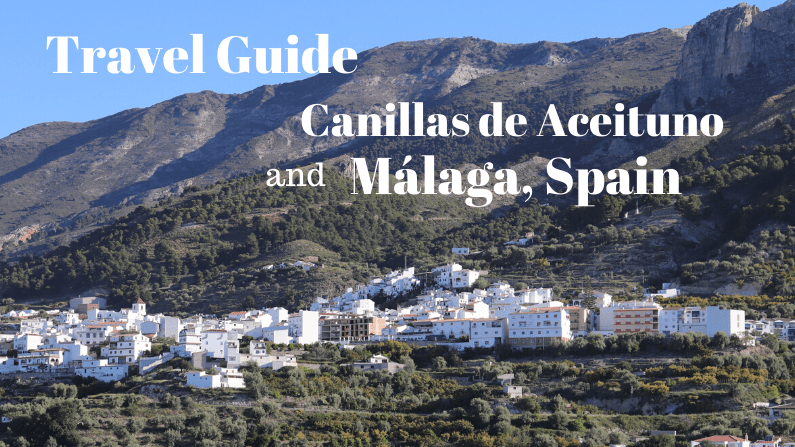
The Simply See The World
Spain Travel Guide
Canillas de Aceituno and Málaga

In this travel guide about Spain, we aren’t going to focus on all of the touristy stuff, because, in fact, that was some of our least favorite parts. So you want to see “the real Spain,” the Spain you see in the movies. The olive and almond groves dotting the steep, craggy terrain of deep valleys and towering peaks and the small whitewashed towns with the idyllic café-lined plazas. Leisurely lunches of jamón and wine with long siestas during the heat of the day. Delicious dinner at 10pm with chivo and tempranillo on the menu. After dinner discoteca for drinks and dancing until the sun comes up making the mountain peaks glow.
Sleep in, and do it again.
If this sounds appealing….then consider visiting Canillas de Aceituno in the region of Andalucía, Spain. You’ll get all that and more.
Quick Note: There’s no such thing as “The real Spain”.
Spain is VERY diverse. Each of the 17 autonomous regions of Spain is just as “real” and “authentic” as the others.
That being said, Andalucía is the region that often comes to mind when most people of Spain.
Andalucía is the southernmost region of Spain and contains Málaga, Seville, Córdoba, Granada, and, of course, this article’s area-of-interest Canillas de Aceituno.
Raychelle and I were lucky enough to spend two months in this region, specifically in the village of Canillas de Aceituno, on a house sitting assignment. In fact, it was the very first assignment of our big around-the-world journey!
Lay of the land
Andalucía stretches from the border with Portugal and the Atlantic Ocean in the west, it borders tiny Gibraltar to the south, and it hugs the Mediterranean Sea on both its south and west. It constitutes a full 17% of Spain’s landmass, or about the size of the US state of Indiana.
Over 8 million people live here, but you wouldn’t know that when you get outside of the cities of the region – much of Andalucía is VERY rural. Like “farmers using horse-drawn carts” rural. Like “you better be at the bus stop on time because there is ONLY one bus each day” type of rural.
Keep reading for a list of the Top 11 Spanish beers!
We fell asleep nightly to the loud, lonely calls of donkeys grazing on the mountainside, and often would walk out to the road to see a shepherd leading his flock of goats past our house to a fresh patch of scrubby grass.
This area is a region of fincas (small farm houses), olive and almond groves, and tiny villages painted uniformly white. It’s as if someone had scattered white grains of rice on a giant brown and green canvas of uneven heights.
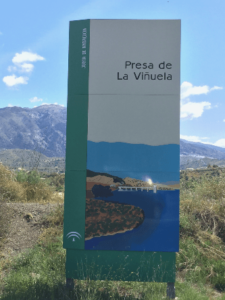
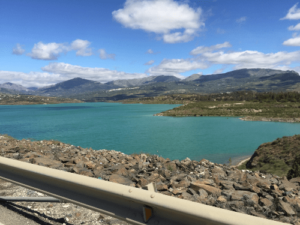
Andalucía is not all countryside, however; it also contains grand cities that highlight Spain’s former colonial wealth. Castles and fortresses are situated on many hilltops offering clues to Spain’s Moorish past.
Moorish, what? Spain was part of a grand Islamic empire from ~700 AD to 1492 AD. These Islamic peoples were collectively known as the Moors.
Wait did you say 1492? That year sounds familiar, doesn’t it?
A Slightly Different Side of Spain
It’s safe to say that this part of Spain is probably different than any place you’ve been, but it will also have a strange familiarity if you’ve traveled to Mexico, Central America, or South America.
Here’s an easy (albeit reductionist) way to think about this area:
Non-coastal or interior Andalucía = small villages (except a few large cities like Granada, Seville, etc) and where a more traditional, slower-paced way of life can be found.
Whereas…
Coastal Andalucía, ESPECIALLY the Costa del Sol = lots of expats (sometimes entire towns of non-Spaniards) and home to a more modernized, globalized, and often faster-paced lifestyle.
The coast has changed A LOT in recent times, beginning with some efforts during the Franco era (a totalitarian leader of Spain from the 1930s to his death in 1975). Since then, it has EXPLODED with development. Now there are high-rise apartment buildings, McDonald’s, malls, and all the trappings of the globalized world.
If you want a McDonald’s, or for that matter even a gas station, you will NOT find it in Canillas de Aceituno.
Most peublas blancas, which are the small villages composed (almost) entirely of white structures and orange-ish roofs, and do not contain chain stores or franchised restaurants.
In many ways, these small towns have preserved a way of life from days gone by and to properly enjoy and appreciate such a place you must SLOW DOWN!
Tranquillo!
You will see are familiar architectural cues: narrow streets (often quite steep and for foot traffic only), buildings with tall vertical façades, church steeples as the tallest structure in the town, courtyards in the center of the houses/buildings, central plazas, and beautiful mosaic tiles.
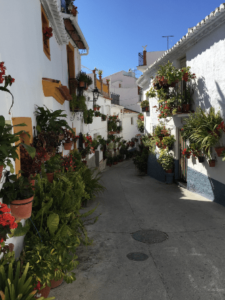 These components of Moorish architecture and design were exported throughout the Spanish empire during Spain’s colonial era (1492 – 1975).
These components of Moorish architecture and design were exported throughout the Spanish empire during Spain’s colonial era (1492 – 1975).
Ok, so enough about the past and the maps…let’s talk travel!
Our time in Canillas de Aceituno, Spain
We flew into Málaga International Airport and drove along the coast and up the mountain to Canillas de Aceituno (a.k.a. Canillas).
It was a misty day, but little did we know this would be the only rain during our stay. For two folks from Indiana to experience a place with ZERO RAIN for two months was VERY different than back home!
We headed east on the A-7, a multilane coastal highway, sandwiched between steep arid mountains and the Mediterranean Sea.
After we left the motorway at the Torre del Mar exit, we found ourselves in Vélez-Málaga. There we saw familiar sights such as McDonald’s and Burger King, as well as new ones like Lidl Supermarket, a German supermarket second only to Aldi in Europe – they both are everywhere.
We started to head up the A-356 towards Canillas de Aceituno, which is one of those classic, idyllic, whitewashed Andalucían villages (aka pueblas blancas) you’ve seen in the movies and in travel brochures.
We stayed in Canillas for FREE for TWO MONTHS!!!
Find out how
YOU can stay for FREE in the travel destinations of your dreams!
Spoiler alert: Canillas de Aceituno is as charming as you would suspect!
The homeowners moved to Canillas to escape the grey skies and rain of England.
It worked!
There are over 320 days of sunshine annually in Canillas. Short, mild winters. Long, hot summers. MUCH less traffic.
Tranquilo!
When we arrived, we observed Canillas from across the steep valley that separated our house from the village. It was a bright and beautiful white pearl situated high on the brownish-green mountainside of Mount La Maroma.
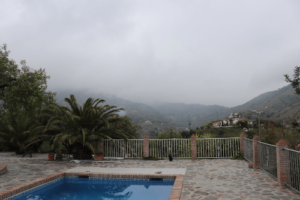 After the homeowners left for their holiday, we were alone as a couple in a new country for the first time on our journey. This would soon be common, but at this point it was new, novel, scary, and exciting.
After the homeowners left for their holiday, we were alone as a couple in a new country for the first time on our journey. This would soon be common, but at this point it was new, novel, scary, and exciting.
During our first weekend in the area, Canillas de Aceituno was having one of its major fiestas.
Party Time!
We naively walked to the village using a trail that we soon discovered to be rather difficult. The trail looked harmless enough, but 3km and the equivalent of roughly 80 flights of stairs later we arrived both sweaty and relieved.
We were ready for a cold beer!
The fiesta takes place the last week of April each year and celebrates the Virgen de la Cabeza, who is carried through town on a litera (yes, one of those things from the movies).

She is accompanied by a full band and a parade of churchgoers following the mass at the Catholic church.
It was a solemn procession and very traditional.
While this is the official reason behind the fiesta, it’s actually all about blood sausage.
Blood sausage? Yes, really.
It’s called morcilla [more – thee – uh] and I’m now a huge fan. Very good, beautiful reddish brown color and grilled to a slight char. Place it between two pieces of bread (pan), coupled with a cold cerveza and – presto! – you’re eating well!
The town had deployed port-a-potties for the event, which had actual porcelain toilet bowls. This would be the first of several juxtapositions between the familiar and the otherworldly (read “holy-cow-that-is-strange/different/weird”) we would witness while in Spain.
Music filled the air and we laughed as the band covered the 1990s one-hit-wonder “Barbie Girl” by Aqua sandwiched within a set of many Spanish songs!
Great festival and an absolute must do if you’re in town in April.
Another festival!
May 15th is the celebration of San Isidro. This festival was housed on the east side of Canillas and a large circus-style tent was erected to house the stage for music and events.

Marching bands, inflatable bounce houses decorated with Disney characters, a curious tractor-like vehicle holding a figure of the Virgin Mary within a complex accompanying tableau, and a long “train” for kids (and big kids) to go for a ride through town.
To our delight, the food and beer was FREE!
Fun in the Sun
The view from Canillas is striking. When we first arrived in late April the Mediterranean was easily viewable most days and what seems to be the faint outlines of the Atlas Mountains across the Sea in Morrocco.
However, towards the end of our stay in late June, the summer heat had introduced a thick haze into the atmosphere. So if you want sea views come between October and April.
We saw the landscape turn from green to brown, and from brown to khaki. And, oh boy, the dust and wind!
Early in our stay, we had days of extreme wind, so windy you couldn’t go outside.
But, no rain. Like, ever. For two months.
The People
Most people in the village are native Spaniards, and many have lived in Canillas their whole lives. There was a finca next to our house where an 86 year-old man named Juan farmed.
As with many other farmers in the area, he lived in the village but had a plot of land with a finca outside of town.
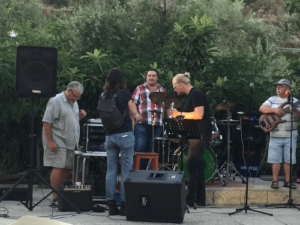
Even though most people are Spanish with local roots, there is a surprising amount of expats here, too – MUCH fewer than on the Costa del Sol, however.
Want great food and pool? La Piscina is a bar next to the municipal pool and is an expat favorite. I was invited to play at an open mic night there, and my three solo songs turned into being essentially the makeshift band leader/guitarist for the entire night.
It was a blast!
Take a Hike!
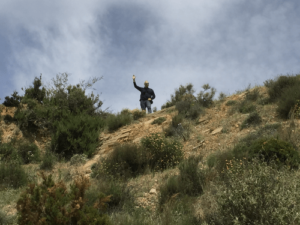
Although there are many interesting hikes in the area, the best one is El Saltillo. The starting point is the village of Canillas, but the actual trailhead is REALLY hard to find.
Go up the hill from restaurant La Maroma and turn right before you get to the goat farm. It’s not marked, unfortunately, so if you start to see and smell goats – turn around, you’ve gone too far.
You’ll know you’re on the right path if you see a small aqueduct ditch along the trail. Also, it’s the only trail; so don’t worry about getting lost. Just walk until you get to the waterfall.
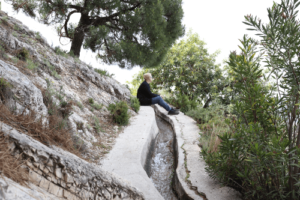
There is a cool suspended walkway made of metal grates and metal cables later in the trail.
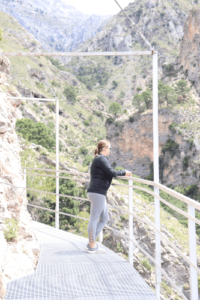
Great views of the mountain, the town of Canillas, and on clear days (basically every day except for summertime) the Mediterranean Sea can be enjoyed along the way.
Don’t turn around early. The end of the trail is the best part.
Be careful of sheer cliffs and your footing on the dirt and rocks. It would be too risky for children on this trail. No guardrails + sheer cliffs = be careful.
When you get back to town we recommend stopping in Bar El Picota for a cerveza and a calamari frito – one of our faves.
For the more experienced hiker, locals recommend summiting Mount La Maroma. It’s about an 8-hour hike and also has a trailhead in Canillas. Modify this hike by starting in nearby Sedella for an easier ascent.
Be sure to pack a LOT of water, especially during the summer.
Eats and Drinks!
Recommended Foods and Dishes in Andalucía:
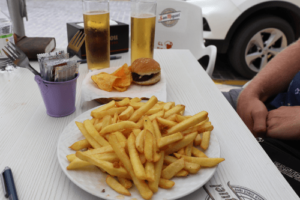 Cocido (pork dish with lots of garlic in a bit of broth, cooked for a loooong time)
Cocido (pork dish with lots of garlic in a bit of broth, cooked for a loooong time)- Papas Fritas (French fries. EVERY Spanish restaurant nails it – they’re better than they should be, great snack with a beer!
- Pan (bread, lots of baguette style breads, all tasty)
- Garbanzos con morcilla (heavy, but delicious)
- Bocadillo de Jamón y Queso – (a really tasty salt-cured, aged ham & cheese sandwich)
- Tortilla España (like a quiche with no pie crust, lots of potatoes, deeeelish!
Best Restaurants and Bars:
- El Picota (Canillas de Aceituno) – True small village plaza bar experience. Old men sit around all day on the nearby town hall steps people watching. Tourists walk and drive through looking both inspired and lost.
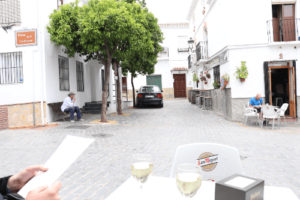
Recommendations at El Picota:
Sit outside to enjoy the entertaining traffic navigating the blind corner – too much fun! Order the calamari frito (a deconstructed sandwich) with a grande sized San Miguel from the tap. This place is CHEAP!
Raychelle and I often had breakfast, lunch, and several drinks each and NEVER paid more than ~ €20 in total!
- Portofino (Nerja) – Great view overlooking Plaza Balcon De Europa and Playa de la Calahonda. Good wine selection, but it’s really about the views and the people watching!

- Restaurante Real Bajo (Vélez-Málaga) – Great Spanish diner. Desert first, beer in the morning, tapas all day – there’s no rules, order what you want when you want.
Top 11 Beers of Spain Ranked:
- Arriaca IPA
- Alhambra
- Estrella Galicia
- Cruzcampo Radler
- Victoria Málaga
- San Miguel
- Cruzcampo Andalucían Pale Ale
- Cruzcampo
- Arriaca Rubia
- San Miguel Manila
- Moritz Barcelona Original
Tasting Notes:
Arriaca IPA is not just a good IPA for a Spanish beer; it’s an IPA that would stand up against most in the US beer scene. A great beer!
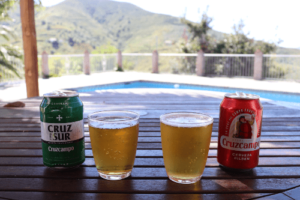 Alhambra is the best light-bodied lager style beer in Spain, period – perfect for hot days and to wash down a jamón sandwich.
Alhambra is the best light-bodied lager style beer in Spain, period – perfect for hot days and to wash down a jamón sandwich.
Estrella Galicia is a bigger bodied, and more flavorful lager. Great accompaniment with dinner.
Want a refreshing beer for after a hike or when you’re REALLY hot? The Cruzcampo Radler will quench your thirst and is an easy drinker; however, one or two and you’re ready for something else.
Attractions and Sights OUTSIDE of Canillas:
Torre del Mar
Visiting the Mediterranean at Torre del Mar was really fun. We walked up and down the coastal walking/biking trail called the Paseo Marítimo and took in the beach views. Tall residential buildings line the beach and the area offers a contrast from the more traditional towns of Andalucía’s interior.
Along the beach you’ll find tables and chairs that are free for the public to enjoy, so we got some supplies from a nearby supermarket and had a picnic!
The Alhambra
The Alhambra is a place many travel guides list as a “must see”. And we agree…to an extent.
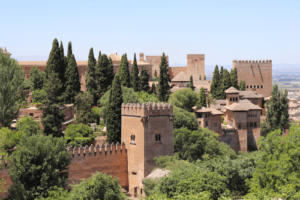 For some visitors, the Alhambra will be absolutely captivating, for most it will be fairly interesting, but for some it is something best avoided.
For some visitors, the Alhambra will be absolutely captivating, for most it will be fairly interesting, but for some it is something best avoided.
Let me explain.
I love history and appreciate architecture, but after about two hours there I was ready to go. I think that finding Moorish history within the context of towns and cities in Andalucía is much more interesting, personally.
But as an architectural marvel (the tile work alone is incredible), cool urban engineering (especially water management), fantastic grounds and garden, and as an important piece of Moorish history it’s worth a visit.
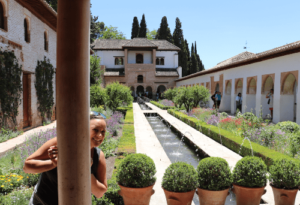
Huge props to the Alhambra grounds team and architectural preservationists – it looks amazing!
Huge jeers to the ticket office – chaos, disorganization, unnecessary queuing, etc – visitors get a runaround and there was no benefit to ordering our tickets online. C’mon! You should be a well-oiled machine since you host TWO MILLION visitors annually…right?
Bottom line: If you’re lukewarm on architectural attractions and are not a history buff then save €30 and don’t devote a day to the Alhambra. But most people will find something they like, and some visitors will be over the moon. Just be sure to pack an extra dose of patience for the ticket office!
Other Attractions: Geology…Rocks!
Geological forces over many thousands of years have created several large caves in the Málaga area. Tesaro Caves (pictured) and the larger Nerja Caves are great places to spend a few hours. Recommendation: Save this for a hot day because the coolness of caves will be a refreshing respite from the heat.
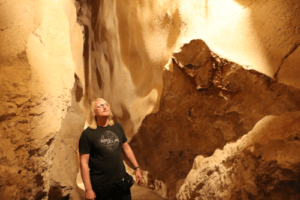
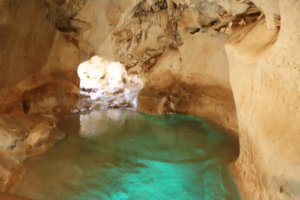
Amongst the Clouds
There are so many charming villages in Andalucía that are both beautiful and high in elevation.
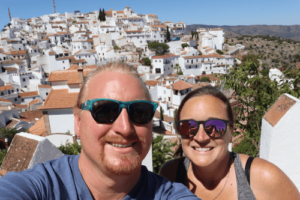
Comares is a little town with unreal views. At only 700m (2300 feet) high, it’s far from being the highest hamlet, but when looking out to the horizon from the central plaza or the ruins of the Moorish castle it appears that you are atop a cloud!

Also, if you fancy a zip line or to do some rock climbing you’ll find it here.
Málaga: A Guide to the City
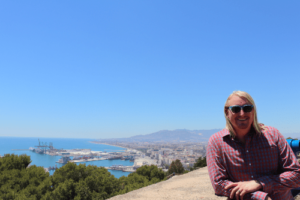
Málaga is a busy, crowded metropolis offering a great diversity of experiences and conveniences unavailable within surrounding villages.
We drove to Málaga and parked underground near Catedral de Málaga, which was less than €10 for the day. We walked along the busy port and saw cars loading on a giant ferry likely bound for the Spanish exclave of Melilla, which is attached to Morocco. Some signs were trilingual: Spanish, English, and Arabic.
We continued on Paseo del Parque and out on the narrow strip of roadway leading to the Málaga Cruise Terminal to see a cool lighthouse called La Farola. Then strolled along the bustling Playa la Malagueta before wandering inland for tapas and beers in the shadow of the historic La Malagueta bullring.

Our thirst quenched, we walked up (way up) to the entrance of Castillo Gibralfaro for a GREAT vista of the city. It is a towering defensive fortress from Málaga’s Moorish past and is worth a look.
Then we continued onto Alcazaba, another Moorish castle, less defensive-focused and more luxurious than Castillo Gibralfaro – it’s kind of a less grandiose version of the Alhambra in Granada.
PRO TIP:
You can see many of the elements of the Alhambra by visiting the Castillo Gibralfaro and Alcazaba. Don’t get me wrong, if you’re a Moorish history buff, architectural aficionado, or a botanical connoisseur you’ll want to go to the Alhambra. If not, save time and money by doing these two attractions instead of the Alhambra.
At the bottom of the hill you’ll see a “recently” unearthed ancient Roman Theater rediscovered in 1951. You’re now back in town and ready for some tapas at nearby Mercado Central de Atarazanas. Raychelle went for a hearty tortilla española with a sangria, while I chose grilled pulpo (octopus), grilled sardines served on a stick, and a beer from the tap.
This is just a taste of Málaga, so be sure to plan at least another day or two if you really want to see all of it.
Málaga is for you if you like…
Málaga is polarizing. Think of it as the Miami of Europe.
If you love the loud, sexy, fashionable, crowded, and the often abrasive chaos of Miami, you’ll like Málaga.
If, like me, you’re not a big fan of Miami, then you’ll enjoy other locales more.
Time for the Beach!
The beaches in Málaga city are busy and loud — and sexy. Málagueños are a good-looking bunch and the weather encourages them to strut their stuff.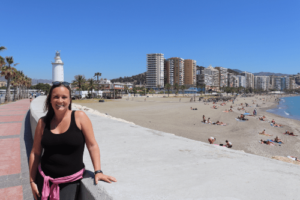
But, you’re over the catwalk-rock-show that is the beach scene in Málaga, and want something more naturally beautiful, quieter, and tranquillo, then check out one of the many small beaches between Málaga and Almería. I recommend Rincón de la Victoria, which is close to Málaga but yet a world away…or, if feeling saucy, pack your birthday suit and head to one of the many nude beaches along the coast.
Wrapping It Up
We at Simply See The World love to travel slow, meet great people, and have awesome experiences without breaking the bank. Canillas de Aceituno ticks all of these boxes and more – for these reasons, we recommend a visit here.
Before setting off on our journey, we did not have this part of Spain on our radar. However, we fell in love with the relaxed vibe, wonderful people, beautiful scenery, and the low cost of living found here.
So don’t limit yourself to Málaga, Granada, or Seville when visiting Andalucía – get off the beaten path to see a more traditional, rural, and intriguing side of Spain! Visit Canillas de Aceituno!

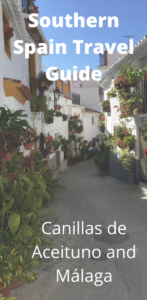

Hi Raychelle…this is an awesome blog!! So fun and helpful. It was great to “catch up” on your adventure. Hi to Chris!
Thanks Kelley,
I am glad you enjoyed it. We are having a great time on our adventure!
Great and informative article! I can definitely hear Chris’s voice in this one!
Thanks Brittany,
Yeah, he did a great job writing it.
Wow you really nailed it..was very informative. And extremely descriptive. Makes us want to see that part of the world..i am however interested in the traditional dress of these places also… I really enjoyed the pics too.. Thank you
Teresa,
We are really glad that enjoyed the post. It is a beautiful part of the world.
As far as traditional dress goes, http://www.andalucia.com/festival/home.htm this website shows a lot about the traditional dress in southern Spain. Festivals are where you will see traditional clothing, day-to-day most Spaniards look very put together and well-dressed (actually in Europe as a whole we have felt pretty underdressed) 🙂